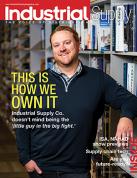Let's keep worrying about the wrong things
How distribution firms can create a more profitable set of priorities
by Dr. Al Bates
 One of the ongoing challenges facing every manager in distribution is setting priorities. Seemingly, everything is important and everything needs attention right now. Unless managers can occasionally step back and evaluate their priorities, they tend to get stuck in a morass of things that appear to be equally important.
One of the ongoing challenges facing every manager in distribution is setting priorities. Seemingly, everything is important and everything needs attention right now. Unless managers can occasionally step back and evaluate their priorities, they tend to get stuck in a morass of things that appear to be equally important.
Without a proper sense of priorities, managers often spend too much time worrying about the wrong things - the things that don't improve profit. This article examines how distribution firms can begin to create a more profitable set of priorities by addressing two issues:
- Analyzing profit opportunities - A financial review of how different management actions impact profitability.
- Opportunity vs. perception - A discussion of the inherent difficulties in keeping employees focused on the greatest areas of opportunity.
Analyzing profit opportunities
The very first requirement in setting profit priorities is understanding how much effort will produce how much reward - in management parlance the proverbial bang for the buck. Exhibit 1 presents some bang for the buck analysis for a representative distribution firm.
| The Impact of a 1% Improvement In Six Key Areas of the Business |
| Area of Improvement | Percentage Increase in Dollar Profit |
| Increase Prices 1% | 32.0 |
| Reduce Cost of Goods Sold 1% | 26.7 |
| Increase Sales Volume 1% | 5.3 |
| Reduce Overhead Expenses 1% | 4.3 |
| Reduce Inventory 1% | 0.7 |
| Reduce Accounts Receivable 1% | 0.3 |
| Exhibit 1 |
Candidly, Exhibit 1 was first developed in the Pleistocene Age. There is probably no senior manager who has not seen Exhibit 1 at least 50 times. However, far too many managers take actions that suggest they are oblivious to Exhibit 1. Consequently, it will be reviewed here for the 51st time.
The exhibit measures the percentage change in dollar profit that will be generated by improving performance by 1 percent in six different areas. For example, the very top line indicates that if a distributor increased its prices by 1 percent, dollar profit for the firm would increase by a staggering 32 percent.
The biggest bang for the buck is in increasing prices, followed fairly closely by lowering merchandise costs through better buying. There is then a perceptible gap before these results and those from increasing sales or reducing expenses. Interestingly, the impact from sales growth and expense control are almost identical. Finally, there is another significant gap before reaching the impact of reductions in either inventory or accounts receivable.
In a perfect financial world, the management team would array its operating priorities to reflect the realities of Exhibit 1. In point of fact, the priorities in most firms deviate widely from what is shown in Exhibit 1, to the detriment of profit performance. Ideally, priorities should be brought back into line with Exhibit 1. In reality, much easier said than done.
Part of the problem is that many managers really don't believe Exhibit 1 even though they have seen it numerous times. Exhibit 2 illustrates how the figures for both sales and prices were derived. The other items in Exhibit 1 follow a similar pattern.
The only item that might not be straightforward in the analysis is that variable expenses were assumed to be 4 percent of sales. This covers commissions, overtime, bad debts, bank card charges and the like.
| The Impact of a 1% Improvement In Sales or Pricing |
| Current | Sales Increase | Price Increase | |
| Net sales | $10,000,000 | $10,100,000 | $10,100,000 |
| Cost of goods sold | $ 8,000,000 | $ 8,080,000 | $ 8,000,000 |
| Gross margin | $ 2,000,000 | $ 2,020,000 | $ 2,100,000 |
| Expenses | |||
| Variable expenses | $ 400,000 | $ 404,000 | $ 404,000 |
| Fixed expenses | $ 1,300,000 | $ 1,300,000 | $ 1,300,000 |
| Total expenses | $ 1,700,000 | $ 1,704,000 | $ 1,704,000 |
| Profit before taxes | $ 300,000 | $ 316,000 | $ 396,000 |
| Increase in profit | 5.3% | 32.0% | |
| Exhibit 2 |
Opportunity vs. perception
Even when everyone is comfortable with the implications from Exhibit 1, firms ignore the exhibit's implications for at least three reasons. First, many firms are cash constrained, which causes them to abandon profit priorities in favor of cash priorities.
Second, some items on Exhibit 1 may be perceived as harder to achieve than they really are. There is a natural tendency to migrate where the effort required is less. Finally, some of the items shown on Exhibit 1 have a much stronger motivational pull than others.
Cash management - The vast majority of distributors are somewhat cash constrained. Generating cash is always an issue. As a result, managers continue to place more attention and effort on reducing inventory and accounts receivable than the exhibit suggests they should.
Such a cash focus is understandable; but is also very wrong. Inventory and accounts receivable reduction programs ameliorate the cash flow problem only in the short run. The only viable solution for solving the long-term cash flow issue is to generate substantially higher levels of profit. Exhibit 1 is not only the path to higher profit, it is the path to more cash.
Degree of difficulty - Certainly it is easier to make changes in some areas than it is in others. In some firms, it may be much easier to reduce inventory than it is to increase prices. The size of the challenge must be considered in planning.
What distribution managers must not do, though, is confuse the difficulty of doing something with its profit impact. That is, they should not decide that just because something is difficult to do it should be avoided. This is especially important in examining the trade-off between different variables.
For example, if gross margin is difficult to improve and inventory is relatively easy to improve (nothing being easy), that should not be an excuse to avoid attacking gross margin. It is essential to understand why this is so.
Taking the sample distributor in Exhibit 1, a 1 percent price increase causes dollar profits to increase by 32 percent. At the same time, a 1 percent reduction in inventory increases profits by only 0.7 percent. These two can be related from a degree of difficulty perspective.
To reach the same level of profit improvement as a 1 percent price increase requires lowering inventory by 44.8 percent (32 percent divided by 0.7 percent). Is it easier for the firm to lower inventory by 44.8 percent or increase prices by 1 percent? The answer may still be inventory. It would be very nice if the answer to focus on inventory were made on the basis of the right information.
Motivational impact - The numbers in Exhibit 1 provide a sense of direction for the firm in terms of where to work. However, they have no value in motivating employees to make changes. This is because some things with a small payoff might be much more fun to do than some things with a large payoff.
As an obvious example, most managers relish opportunities to increase sales. It is a dynamic process. In contrast, expense control often has the same motivational component as cleaning the leaves out of the gutters. It probably ought to be done, but it sure isn't much fun.
Even increasing prices, which is king of the hill in Exhibit 1, may have a negative connotation. If there is a deep-seated belief within the firm that prices are too high, then prices really are too high. Perception, even when utterly wrong, is reality. To urge the firm to move forward without a proper belief in what is being done is folly. The motivational component associated with the various activities in Exhibit 1 must be central to management's thinking.
Moving forward
If distributors are going to generate higher levels of profit, they must pay homage to Exhibit 1. However, it is not enough to simply make sure every member of the management team understands Exhibit 1. Every member must set priorities that actively support Exhibit 1.
Making Exhibit 1 an integral part of management action requires a strong motivational effort. That effort needs to be ongoing rather than episodic. It is a lot of work. The payoff, though, is a lot of profit.
Excerpted from Profit Myths in Wholesale Distribution. Dr. Albert D. Bates is founder and president of Profit Planning Group, a distribution research firm headquartered in Boulder, Colo.













